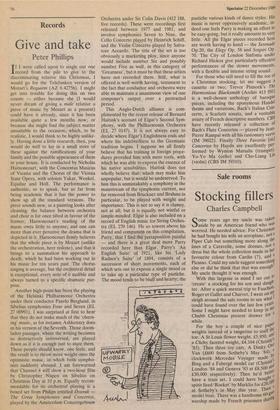Records
Give and take
Peter Phillips
II were called upon to single out one 'record from the pile to give to the discriminating relative this Christmas, I would go for the Telefunken version of Mozart's Requiem (AZ 6.42756). I might get into trouble for doing this on two counts — either because she (I would never dream of giving a male relative a piece of music by Mozart as a present) could have it already, since it has been available quite a few months now; or because she might find the subject matter unsuitable to the occasion, which, to be realistic, I would think to be highly unlike- ly. Having done a little research, then, you would do well to lay in a small store of these against the ramifications of your family and the possible appearance of them in your house. It is conducted by Nicholas Harnoncourt, with the Concentus Musicus of Vienna and the Chorus of the Vienna State Opera, with soloists Yakar, Wenkel, Equiluz and Ho11. The performance is authentic, so to speak, but so far from being academic that it has the power to show up all the standard versions. The piece sounds new, as a painting looks after cleaning: the balance between orchestra and choir is for once tilted in favour of the former; Harnoncourt's reading of the music owes little to anyone; and one can more than ever perceive the drama that is depicted in it. Harnoncourt firmly believes that the whole piece is by Mozart (unlike the orchestration, here redone), and that it brings to a summation his approach to death, which he had been working out in his music for ten years past. The chorus singing is average, but the orchestral detail is exceptional, every note of it audible and always turned to a specific dramatic pur- pose.
Another high-point has been the playing of the Helsinki Philharmonic Orchestra under their conductor Paavlo Berglund, in Sibelius symphonies Four and Seven (EL 27 00991). I was surprised at first to hear that they do not make much of the 'churn- ing' music, as for instance Ashkenazy does in his version of the Seventh. Those doom- laden passages, where the writing becomes so destructively introverted, are played down as if it is enough just to state them. These people should know, one feels, and the result is to throw more weight onto the optimistic music, in which both sympho- nies suddenly abound. I am forewarned that Channel 4 will show a two-hour film by Christopher Nupen on Sibelius on Christmas Day at 10 p.m. Equally recom-
mendable for its orchestral playing is a boxed set from Philips entitled Dvorak The Great Symphonies and Concertos, played by the Amsterdam Concertgebouw
Orchestra under Sir Colin Davis (412 188, five records). These were recordings first released between 1977 and 1981, and involve symphonies Seven to Nine, the Cello Concerto played by Heinrich Schiff, and the Violin Concerto played by Salva- tore Accardo. The title of the set is too obviously a marketing ploy, since anyone would include number Six and possibly number Five as well, in this category of 'Greatness', but it must be that these artists have not recorded them. Still, what is offered is well worth having, testament to the fact that conductor and orchestra were able to maintain a unanimous view of one composer's output over a protracted period.
This Anglo-Dutch alliance is com- plimented by the recent release of Bernard Haitink's account of Elgar's Second Sym- phony, with the Philharmonia Orchestra (EL 27 0147). It is not always easy to decide where Elgar's Englishness ends and where his indebtedness to the Germanic tradition begins. I suppose we all firmly believe that his training in foreign proce- dures provided him with mere tools, with which he was able to express the essence of his native sensibilities. Haitink does not wholly believe that; which may make him unpopular, but it would be undeserved. To him this is unmistakably a symphony in the mainstream of the symphonic current, not far removed from Bruckner and Brahms in particular, to be played with weight and importance. This is not to say it is clumsy, not at all; but it is equally not wistful or simple-minded. Elgar is also included on a record of English music for String Orches- tra (EL 270 146). He so towers above his friend and companion on this compilation, Parry, that I find the juxtaposition painful — and there is a great deal more Parry recorded here than Elgar. Parry's 'An English Suite' of 1921, like his 'Lady Radnor's Suite' of 1894, consists of a succession of short movements, each of which sets out to express a single mood or to take up a particular type of pastiche. The mood tends to be bluff and hearty; the
pastiche various kinds of dance styles. His music is never oppressively academic, in- deed one feels Parry is making an effort to be easy-going, but it really amounts to very little. All he Elgar pieces recorded here are worth having to hand — the Serenade Op.20, the Elegy Op. 58 and Sospiri Op. 70. The City of London Sinfonia under Richard Hickox give particularly effective performances of the slower movements, with a flexible and intense string sound. For those who still need to fill the toe of a Christmas stocking, let me suggest a cassette or two; Trevor Pinnock's The Harmonious Blacksmith (Archiv 413 591) is a well-chosen anthology of baroque pieces, including the eponymous Handel theme and variations, Bach's Italian Con- certo, a Scarlatti sonata, and a veritable aviary of French descriptive numbers. CBS have recently released a collection of Bach's Flute Concertos — played by Jean' Pierre Rampal with all his customary verve (IM 39022). Finally Three Favorite [sic] Concertos by Haydn are excellently per- formed by Wynton Marsalis (trumpet)' Yo-Yo Ma (cello) and Cho-Liang Lin (violin) (CBS IM 39310).






































































 Previous page
Previous page